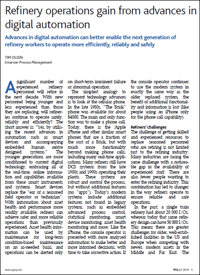 For producers of commodity products, profitability primarily comes from operational excellence—that is optimizing costs to run the process as efficiently as possible. In the U.K-based PTQ article, Refinery operations gain from advances in digital automation, Emerson’s Tim Olsen highlights ways petroleum refiners can use technologies to improve production levels and reduce costs.
For producers of commodity products, profitability primarily comes from operational excellence—that is optimizing costs to run the process as efficiently as possible. In the U.K-based PTQ article, Refinery operations gain from advances in digital automation, Emerson’s Tim Olsen highlights ways petroleum refiners can use technologies to improve production levels and reduce costs.
We’re in the midst of a generational shift losing vast amounts of experience to retirement. Tim notes:
The younger generations are more conditioned to current digital technology, embracing all of the real-time, online information and capabilities available from these smart instruments and systems. Smart devices replace the “ear of a seasoned field operator or technician”.
One example is in continuous asset monitoring:
Asset health information can be used by maintenance for long-term condition-based maintenance on an as-needed basis, and operations can be alerted only on short-term imminent failure or abnormal operation.
Not only is replacing experienced personnel an issue for refiners, so is competition for older plants from the more modern and efficient plants:
For example, when demand is down in one region, opportunities arise to find consumers in other markets where production and distribution costs make this economically attractive. Basically, this means that modern refiners with lower operating costs can look for additional opportunity markets beyond their own regional markets.
Production is lost through unplanned downtime. Tim shares how aging plant equipment increases the likelihood of unplanned downtime:
Unplanned shutdowns incur costs beyond lost production. Emergency shutdowns and subsequent startups put abnormal wear-and-tear demands on equipment, increase catalyst and chemical losses, produce off-spec products and require additional manpower, overtime and expedited 24-hour service.
There are several ways automation technologies can help address these issues. One way is in spotting process variability [hyperlink added]:
Modern systems with statistical monitoring can report on control loops with high variability or excessive alarms. What used to go unnoticed in the past is now front and centre to get attention. Other examples on using data from the control system include historical data analysis, simulation for operator training for startups, shutdowns and abnormal situations, and real-time instrumentation diagnostic alerts. These alerts translate into reduced costs:
Refiner feedback estimated a manpower saving of 1.6 hours per instrument, per year, by automating instrumentation work practices and reducing trips to the field. For a large refinery with over 10 000 process inputs, a digital solution could save 16 000 hours per year, for instrument and valve maintenance.
Tim provides many other examples including how embedded advanced control in modern systems:
…that allow fast execution so distillation columns can be operated at minimum reflux, compressor recycles lowered, heater excess air reduced, catalyst losses minimised, heat recovery maximized and so on, all impacting the total energy consumed by the refinery. Using APC technology, refiners can be assured that the control system only utilises the right amount of energy needed to economically recover the most valuable products.
Another example is moving from manual equipment monitoring to continuous monitoring:
On average, a refiner has hundreds of process pumps with only about 10% monitoring online. The remaining pumps are checked manually, typically once per month. This has been found to be insufficient in preventing pump failures and the potential safety and environmental incident associated with unscheduled shutdowns.
Tim offers several more examples and I encourage you to read the article for ways to use technology to improve efficiency—even if your production process is outside of refining.





